Aloe Vera is a beautiful succulent that is easy to grow and found in many households. It is a great plant for beginners because it is forgiving and tolerates different conditions. But one common problem found in these plants is drooping.
Incorrect watering, inadequate lighting, pest infestations, and intense heat are common reasons behind droopy aloe vera. Exposing the plant to the wrong environmental conditions can also cause droopy leaves. Provide adequate water, and save the plant from intense heat to prevent droopy leaves.
If you want to understand the reasons behind a droopy aloe vera plant and find out how to treat it, go through this article.
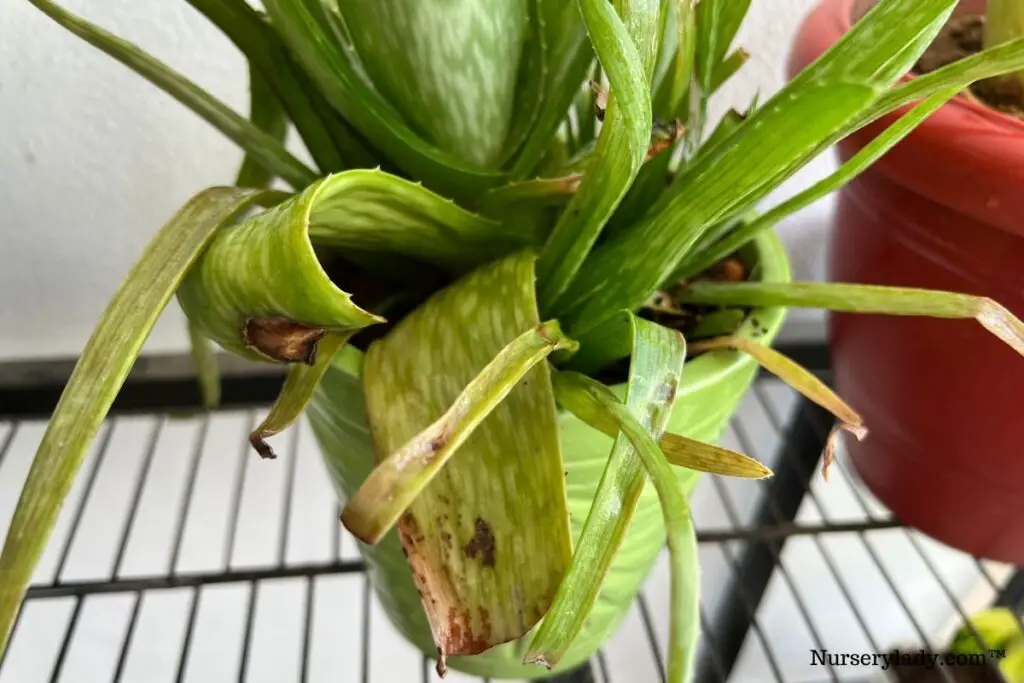
Why is my aloe vera plant droopy?
It is not uncommon to see droopy leaves on an aloe vera plant as mistakes can happen.
If you find droopy leaves on your aloe, don’t panic and try to identify the issue so you can address and fix it quickly.
Here are the reasons behind a droopy aloe vera plant.
Overwatering
Overwatering is common and dangerous.
One common misconception about watering is that if you give your aloe vera plant more water, it will thrive.
But that is not true as aloe vera is succulent, so it doesn’t require excess watering.
So, if you think the droopy leaves are due to overwatering, check the soil and the leaves.
The leaves become soft due to the excess water and develop soak spots.
On the other hand, the soil also feels moist when you touch it.
How to treat an overwatered aloe vera plant?
If you have an overwatered aloe vera, follow these steps:
- Stop watering and give the soil time to dry out.
- If you have an outdoor aloe vera, take it out and transplant it in a dry spot if the soil doesn’t get dry easily.
- For a potted aloe vera plant, you can take the plant out and let the roots and the soil dry out by spreading them on paper under bright light.
- If you suspect root rot, you need to look for brown and soft roots and prune them. The next thing to do is spray fungicide on the healthy roots and repot the plant in a new pot with new soil.
- After the aloe vera recovers, provide water only after the soil dries out completely. In general, aloe vera will require water once in 2-3 weeks during the spring and summer months.
Also read: How To Water Aloe Vera Plant? (How often, Summer, Winter)
Poor drainage system
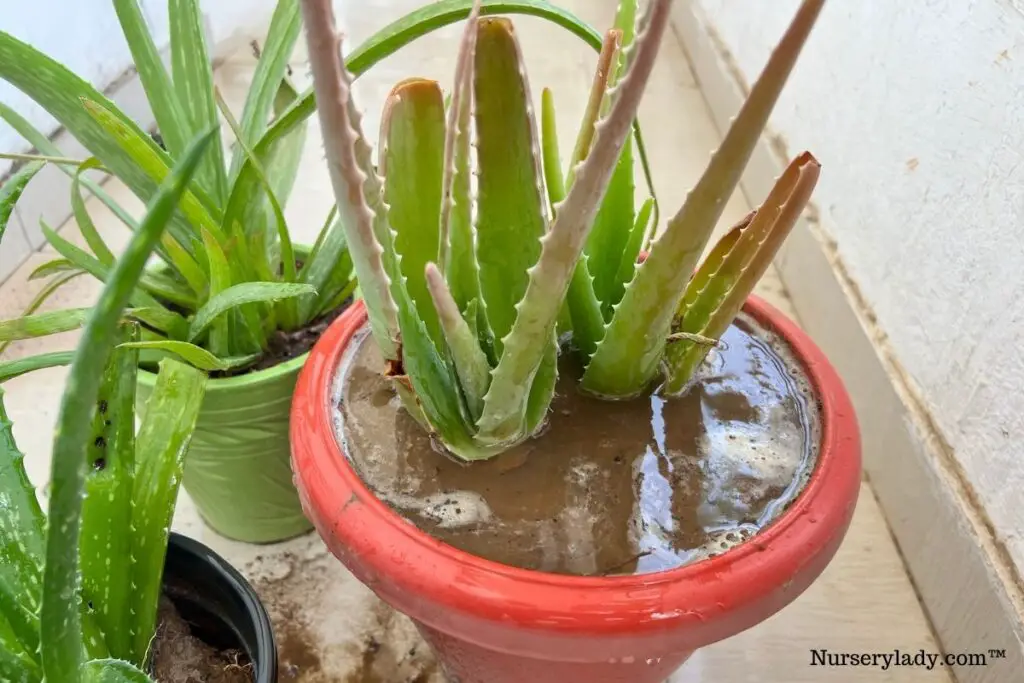
Sometimes you might be watering your aloe vera once in 2 to 3 weeks, but still, you find it overwatered and its leaves droopy.
If this is the case with your aloe vera, the problem is not watering but the drainage system.
If the soil you are using doesn’t drain the excess water or if the pot of the aloe vera doesn’t have drainage holes, the water will not have a way of draining out, keeping the soil wet for too long.
How to fix the drainage system of aloe vera plants?
Consider the following points if your aloe vera has a poor drainage system.
- For outdoor aloe veras, planting them in raised beds will improve the drainage.
- You can also either add compost or manure to improve the soil’s drainage.
- For potted aloe veras, always get a pot with drainage holes.
- You can also use succulent or cactus soil for your aloe vera as it will drain the excess water very well.
Also read: What Type Of Soil For Aloe Vera Plant? (+Ideal Soil Mix)
Looking for gardening supplies? We have tested 100's of products before recommending them to you guys. Check out our best pick below:
| Image | Gardening Supplies | Best Price? |
|---|---|---|
 Top
Top Top
Top | Raised Garden Bed Kit | Check On Amazon |
 | XLUX Soil Moisture Meter, Plant Water Monitor, Soil Hygrometer Sensor for Gardening, Farming, Indoor and Outdoor Plants, No Batteries Required | No Results |
 Top
Top Top
Top | 82 Pcs Garden Tools Set and Extra Succulent Tools Set | Check On Amazon |
 | Joeys Garden Expandable Garden Hose with 8 Function Hose Nozzle, Lightweight Anti-Kink Flexible Garden Hoses, Extra Strength Fabric with Double Latex Core, (50 FT, Black) | No Results |
 Top
Top Top
Top | Dual Chamber Compost Tumbler | Check On Amazon |
 Top
Top Top
Top | Sunnyglade Plant Stakes | Check On Amazon |
 Top
Top Top
Top | Organic Cold Pressed Neem Seed Oil | Check On Amazon |
 Top
Top Top
Top | Mighty Mint Gallon :-Insect and Pest Control Peppermint Oil | Check On Amazon |
 Top
Top Top
Top | Scotts DiseaseEx Lawn Fungicide | Check On Amazon |
 Top
Top Top
Top | Jacks Classic 20-20-20 All Purpose Fertilizer | Check On Amazon |
 Top
Top Top
Top | 30,000 Seeds Pollinator Attracting Wildflower Mixture | Check On Amazon |
 Top
Top Top
Top | Survival Vegetable Seeds Garden Kit-Over 16,000 Seeds | Check On Amazon |
Underwatering
Aloe vera is succulent, indicating that its water requirements are low.
However, with that in mind, you might forget to water it for a prolonged period, and at one point, it can become a problem for the plant.
An aloe vera will survive without water for a long period as its leaves contain water that it will use when it doesn’t get enough water from outside.
But when the water content of the leaves reduces, they will droop.
How to fix an underwatered aloe vera?
If you have an underwatered aloe vera that needs some attention, here’s what you should do:
- Give the plant a good soak.
- For the potted aloe vera, poke the holes with a chopstick and pour water till it starts draining out of the drainage holes.
- You can take the aloe vera out of its pot and put it in a container or bucket filled with water, and leave it for a few hours. This will allow the soil to soak water properly.
You should see the leaves coming back to normal within an hour or two.
Also read: Can Aloe Vera Plant Grow In Water? (How To+Things To Remember)
Low light

If your aloe vera doesn’t receive enough light, it will not thrive.
Aloe veras are succulents, so they need direct sunlight.
If your aloe vera doesn’t get 6 hours of direct sunlight, it will be low on energy, and therefore, the leaves will droop.
You might also notice pale leaves or unusual white spots.
How to provide more light to your aloe vera plant?
If you have potted aloe veras, you must place it in front of a sunny window so it can get at least 3-6 hours of direct sunlight.
However, to ensure that your aloe doesn’t get too intense direct sunlight, you can place it in an east-facing window.
If your aloe vera is not getting enough sunlight, you can use a grow light to provide enough light to it.
For outdoor aloe veras, plant them in a sunny spot where they will get 6 hours of direct sunlight.
You must not plant the aloe vera in a spot blocked from direct sunlight.
Also read: What Kind Of Light For Aloe Vera Plants? (Full sun, Shade, Or Partial Light?)
Pest infestation
Aloe vera doesn’t get pests easily, but it might have a scale infestation if placed in unfavorable conditions.
Other pests that might attack the aloe vera are aphids, aloe mites, and mealybugs.
Most pests suck the sap out of the plants and make the leaves droopy.
Aloe mites are too small to be noticed, but you will notice distorted leaves if your aloe vera has an infestation.
How to remove pests from the aloe vera plant?
You can take a cotton swab, dip it in rubbing alcohol, and wipe the infected parts of your aloe vera to remove the pests.
You must prune the heavily damaged leaves and spray a neem oil solution or an insecticidal soap all over your aloe vera.
However, if your aloe vera has an aloe mites infection, it will be difficult for you to save the plant from it.
Aloe mites do irreversible damage to your aloe vera.
Some might see success in treating it with an effective pesticide, while some might see no or meager success.
If no treatment works, you should isolate your aloe vera and save the other houseplants.
Bacterial and Fungal infections
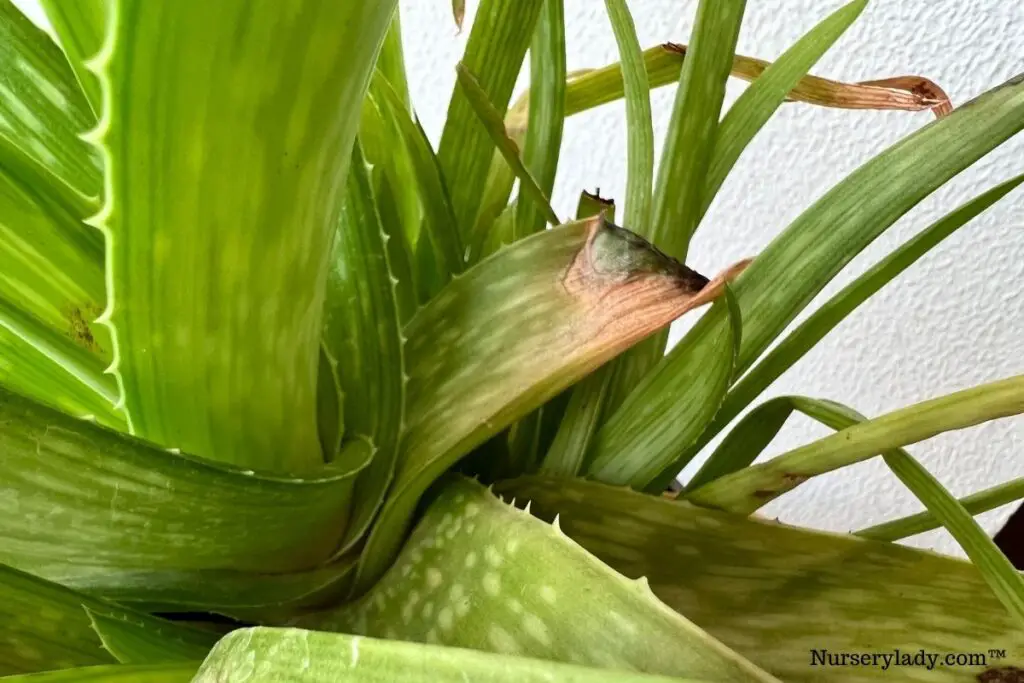
Some bacterial and fungal diseases can make your aloe vera unhealthy with droopy leaves.
Let’s take a look at some of these diseases.
Bacterial soft rot: Aloe vera doesn’t need excess watering or humidity, but the plant develops bacterial soft rot when it gets that.
If your aloe vera has bacterial soft rot, you will notice
- Dark spots
- Bulges on leaves
- Droopy leaves
Basal stem rot: This disease is also due to overwatering or excess moisture.
You will notice browning of the base of your aloe vera plant.
This indicates that the stem is rotting.
Aloe rust: Aloe rust will occur if your aloe vera is exposed to low temperatures along with excess moisture.
If your aloe vera plant has aloe rust, you will find tiny yellow spots that will eventually grow bigger and turn browner.
How to treat bacterial and fungal infections on your aloe vera?
Now, let’s understand how to counter each of these diseases.
Bacterial soft rot: If your aloe vera has bacterial soft rot, you might not be able to save the plant as it spreads very fast and infects the entire plant.
So, you might need to discard your aloe vera.
But if you want to prevent this disease, you must not overwater your aloe vera and provide the ideal warm conditions.
Basal stem rot: Basal stem rot can’t be cured either.
Once your aloe vera is infected, it will die.
But you can take a healthy cutting and propagate the plant to give it a chance and discard the rest of it.
Aloe rust: Aloe rust is not as damaging as the other two diseases and won’t kill your aloe vera.
It can affect one or more leaves, so it is best to prune them, so the disease doesn’t spread further.
Always disinfect the pruners after using them.
Rootbound plant
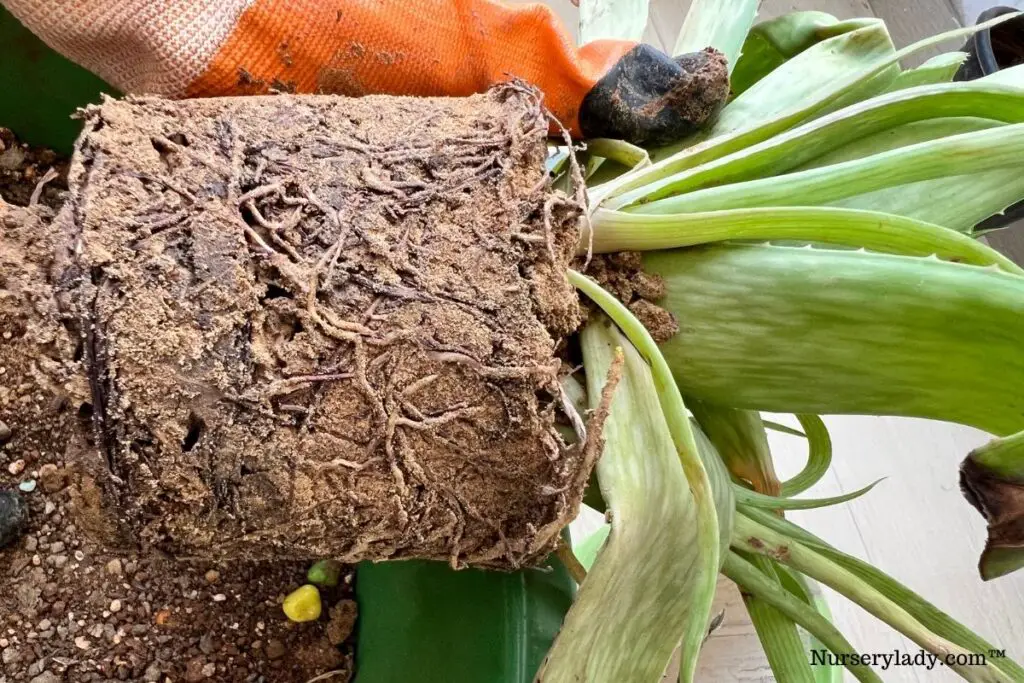
A rootbound plant is likely to develop droopy leaves.
Rootbound means that your aloe vera has outgrown its current pot and its roots require more space.
When the roots grow larger than the pot, they start growing in a circular motion, displace the soil and fail to function.
The plant doesn’t get enough nutrients or water and becomes weak in such a condition, leading to droopy leaves and stunted growth.
How to fix a rootbound aloe vera plant?
If you have a rootbound aloe vera plant, you should repot it.
You must select a pot 1-2 sizes larger than the previous pot and not go overboard with it.
To repot your aloe vera:
- Take your aloe vera out of its old pot.
- Clean the soil from the roots so you can inspect them.
- Gently untangle the roots that have formed clusters.
- Take the new pot and add some succulent mix or the potting mix you have prepared.
- Place your aloe vera in the pot.
- Add soil from the sides.
- Water the plant after a few days.
Also read: What Pot Is Best For Aloe Vera Plant? (Pot Type, Size & More)
Transplantation or repotting stress
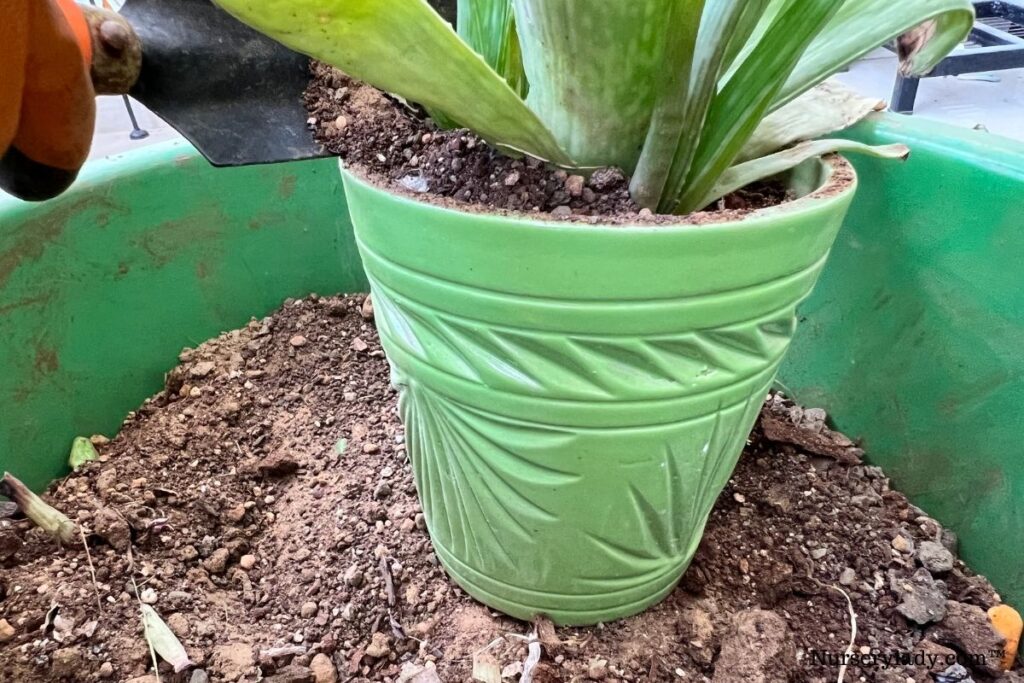
Repotting or transplantation is usually a big change for any plant.
When you repot or transplant your aloe vera plant, it goes through some stress before it can adjust entirely and look healthy.
You might notice droopy leaves during this phase when the plant is undergoing stress.
You have nothing to do here but give the plant time and take proper care of it.
If the plant is not experiencing any other issues, it will bounce back in a few days along with its leaves.
Temperature stress
Aloe vera will not enjoy temperature fluctuations.
Although aloe vera can tolerate temperatures beyond its ideal range, you shouldn’t expose it to them because it will stress the plant.
The ideal temperature for indoor aloe veras is 60-75°F, and you should try to maintain that.
If your aloe vera is stressed due to temperature fluctuations, its leaves will droop.
How to maintain the ideal temperature for aloe vera?
- You must not place your aloe vera near windows or doors opened and closed frequently.
- Avoid exposing your aloe vera to intense sunlight.
- Don’t keep your aloe vera near heating sources like a fireplace or a radiator.
- Protect the aloe vera from low temperatures, frost, and hot or cold drafts.
Also read: Aloe Vera Temperature Tolerance: Ideal Temperature+Keeping Them Safe
Sudden relocation
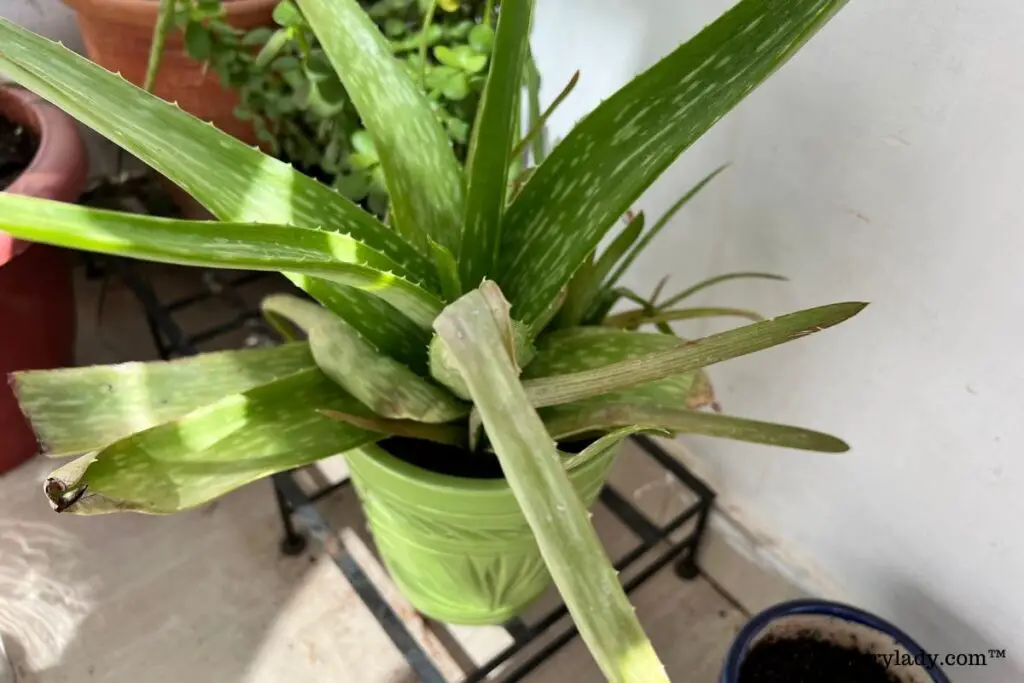
Another reason for sudden stress in your aloe vera plant might be sudden relocation.
For example: taking your indoor aloe vera outside and leaving it there for hours.
If you suddenly move any plant to a very different environment, the plant will get stressed, and the leaves will droop.
How to move the aloe vera plant without causing stress?
If you don’t want to cause stress to your aloe vera and still move it to a different location, you need to do it gradually.
If you want to move an outdoor aloe vera inside, you need to start placing the plant in a shaded spot and checking how the plant reacts.
After doing this for a few days, move the plant inside in a warm environment and let it adjust for another few days.
If the plant reacts well to everything, you can move the plant inside permanently.
Also read: Where Should Aloe Vera Plant Be Kept? (Ideal Spot+Points To Remember)
How do you make aloe vera Stand Up?
Follow these methods if you want to make your aloe vera plant stand up.
- You can buy stakes available online and support your aloe vera with it. You can support one or more leaves or the entire plant. For making the entire plant stand up, you will need 4-5 stakes.
- You can add a stone at the base of the droopy leaf to help it stand up.
- You can also repurpose household items and use them to help your aloe vera plant stand up.
Reference: NCBI, New York Botanical Garden, University of New Hampshire, University of Florida, Wikipedia.
